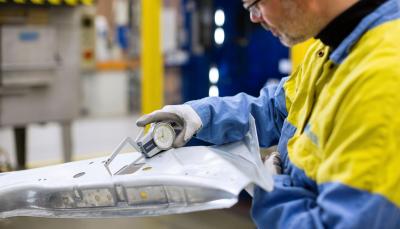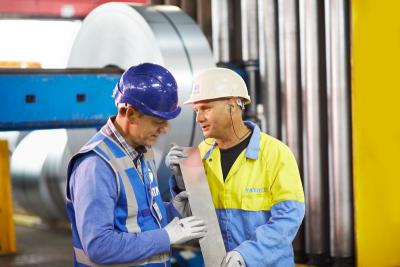EN-construction-services-guarantees-platinum-plus
Platinum® Plus is a system guarantee for 25 years, that covers durability, structural and thermal performance.

<a href=/product-ranges/automotive/electro-plated-steel>Tata Steel is a committed partner within the automotive industry. Combining ourmaterials, design eng...</a>

<a href=/product-ranges/automotive/metallic-coated>Tata Steel offers a wide choice of metallic coated steel for inner and outer panels. Our product ran...</a>

<a href=/product-ranges/construction>Taking a proactive approach, we are unique in sharing our deep knowledge of steel, advising on how t...</a>

<a href=/product-ranges/engineering/metallic-coated>Tata Steel offers a wide choice of metallic coated steel.</a>

<a href=/product-ranges/packaging>As one of Europe’s leading suppliers of high-quality packaging steels, we work closely with our bu...</a>

<a href=/product-ranges/plating/electro-plated>At Tata Steel Plating we work closely with our customers to find cost-effective solutions to technic</a>

<a href=/product-ranges/tubes/structural-tubes>Cold formed welded steel structural hollow sections supplied to EN10219.Produced with precision and ...</a>

<a href=/coil-data-on-demand>Make better decisions and reduce lead times with direct access to coil data. You can now empower you...</a>

<a href=/automotive/aurora-online>High quality data and expert advice to make your simulations easier to set up and more accurate.
</a>

<a href=/brands/automotive/hilumin>HILUMIN®for cylindrical battery cell casings in electric vehicles.</a>

<a href=/brands/automotive/hi-lite>Hi-Lite:a thin non-oriented electrical steel for efficient and high-performance electric motors.</a>

<a href=/brands/automotive/hyperform>Hyperform®: extra formability for lightweight AHSS design.Tackling weight, costs and performance si</a>

<a href=/brands/automotive/magizinc-auto>MagiZinc®Auto: advanced hot-dip galvanisedcoating for inner parts and outer panels.</a>

<a href=/brands/automotive/plt>Prime Lubrication Treatment:advanced surface treatment for smooth processing of automotive panels.</a>

<a href=/brands/automotive/serica-flo>Serica®FLO:a premium surface finish for a market-leading paint appearance.</a>

<a href=/brands/automotive/xpf>XPF® for easy lightweighting and improved energy absorption in complex structural vehicle parts.</a>

<a href=/brands/automotive>Brands in the Automotive product portfolio</a>

<a href=/brands/engineering/magizinc>MagiZincis an innovative replacement for conventional galvanised steels. It provides superior corros...</a>

<a href=/brands/engineering/valast>Valast® wear resistant steel is developed to withstand the most demanding conditions. Discover how ...</a>

<a href=/product-ranges/engineering/direct-rolled/high-strength-steel>Ymagine® direct-rolled steel comes in five high-strength, low-alloy (HSLA) grades offering either w...</a>

<a href=/brands/engineering/ympress>Ympressis a hot-rolled, high-strength, low-alloy steel with outstanding formability and consistent p...</a>

<a href=/brands/engineering/ympress-laser>Tailor-made for efficient, high-speed laser cutting, this homogeneous, hot-rolled steel combines exc...</a>

<a href=/brands/engineering/ymvit>Tata Steel’s Ymvit cold-rolled steel for enamelling delivers end product and process benefits incl...</a>

<a href=/brands/engineering>Discover our engineering brands for various applications in the heavy vehicles sector, solar constru...</a>

<a href=/brands/packaging/protact>Protactlaminated steel is food-safe and optimised for efficient, sustainable canmaking with opportun...</a>

<a href=/brands/packaging/tcct>Asustainable, reliable replacement for conventional tin-free packaging steel (ECCS) developed by Tat...</a>

<a href=/brands/packaging>We make steel for packaging. Our specialist steels are designed for food and drinks cans, aerosols, ...</a>

<a href=/steel-service-centre-feijen>Our service centre in Maastricht (Feijen) is part of our highly specialised distribution service for...</a>

<a href=/steel-service-centre-multisteel>MultiSteel offers one of the broadest multi-metal ranges in Europe, including HRP, CRC, HDG, DSP and...</a>

<a href=/steel-service-centre-unitol>Our Unitol steel service center in Corbeil-Essonnes, France, offers one of the broadest ranges of st...</a>

<a href=/steel-service-centre-gelsenkirchen>Our Gelsenkirchen plant, producing slit coils and cut-to-size sheets, include slitters and blanking ...</a>

<a href=/steel-service-centre-layde>Layde steel slu is located in the north of Spain, the Basque Country.For the transformation of coils...</a>

<a href=/expertise/automotive/applications/energy-storage>Enabling the transition to electrified vehicles by providing solutions for cylindrical battery casin</a>

<a href=/expertise/automotive/applications/seating>Steel design for automotive seats</a>

<a href=/expertise/automotive/applications/body-in-white>Supporting you from concept to series production. Increased energy absorption in BIW parts, reducing...</a>

<a href=/expertise/automotive/applications/chassis-and-suspension>Helping you strike the balance in chassis design.</a>

<a href=/expertise/automotive/applications/outer-panels>SericaFLO for excellent paint appearance on outer panels with appealing designs that are enabled by ...</a>

<a href=/applications/automotive-applications>Tata Steel offers a wide, multi-product portfolio of strip, tubes and forging steels, including a sm...</a>

<a href=/expertise/engineering-applications>Steel applications for construction equipment, consumer products, industrial applications, steel pro...</a>

<a href=/expertise/engineering/case-studies/bergerecotrail>Using Ympress® S700MC to manufacture BERGERecotrail® semi-trailer bodies and welded-frames for the...</a>

<a href=/expertise/engineering/case-studies/frank-original-boron-manganese>Expansion of boron manganese steel offering for agricultural machinery in partnership with Frank Wal...</a>

<a href=/expertise/engineering/case-studies/hyster-yale>Opportunities for Hyster Yale to deliver lower total cost of ownership to its customers.</a>

<a href=/expertise/engineering/case-studies/jcb-landpower>EnablingJCB to develop an optimally-designed next-generation tractor.</a>

<a href=/expertise/engineering/case-studies/kuhn-gyrotedders>KUHN co-developed a newhollow section specification:Hybox TT.</a>

<a href=/expertise/engineering/case-studies/linssen-yachts>S235 steel products create ultra-smooth hulls for Linssen Yachts.</a>

<a href=/expertise/engineering/case-studies/palfinger>Crane maker Palfinger benefits from a unique partnership.</a>

<a href=/applications/engineering-case-studies>We can make a real difference to your performance by understanding your business and delivering stee...</a>

<a href=/applications/engineering-case-studies>We can make a real difference to your performance by understanding your business and delivering stee...</a>

<a href=/applications/engineering-case-studies>We can make a real difference to your performance by understanding your business and delivering stee...</a>

<a href=/applications/engineering-case-studies>We can make a real difference to your performance by understanding your business and delivering stee...</a>

<a href=/applications/engineering-case-studies>We can make a real difference to your performance by understanding your business and delivering stee...</a>

<a href=/applications/engineering-case-studies>We can make a real difference to your performance by understanding your business and delivering stee...</a>

<a href=/expertise/packaging/applications>Our packaging steel products are designedfor a diverse range ofapplications from aerosols to food ca...</a>

<a href=/expertise/packaging/case-studies/bonduelle>Two thirds of Dutch consumers didn'tknow that a can is endlessly recyclable according to consumer re...</a>

<a href=/applications/packaging/case-studies/snert>Joris Bijdendijk is a renowned Dutch chef at the Michelin-starred RIJKS restaurant, located next to ...</a>

<a href=/expertise/packaging/case-studies/calvo-vuelca-facil>Consumers, from older users to children can sometimes find traditional tuna cans difficult to use du...</a>

<a href=/expertise/packaging-case-studies>We can make a real difference to your performance by understanding your business and delivering stee...</a>

Responsible sourcing helps to reduce risk in building specification and performance by designing resiliency into our built environment.
Phrases like ‘climate emergency’ are a much more common part of everyday conversation. Clients and building owners are more aware of the challenges we face, and architectural and construction professionals are being reminded of their duties to promote a change of culture rather than ‘business as usual’. That is emphasising resource use and responsible sourcing.
The onus for responsible sourcing is on manufacturers, who should be able to demonstrate that their raw materials come from well-managed sources, and the way in which products are manufactured does not have undue environmental impact.
Part of managing risk is thinking about how a building will perform in 30 or 50 years’ time, when the unpredictability in our climate will be more extreme than it is now. Specifiers need detailed and accurate information in order to make decisions about the products and materials they incorporate into designs.
Sourcing raw materials and using them responsibly is a part of designing resiliency into our built environment, protecting building users from the effects of changing climate, and reducing our impact on our surroundings.
Life cycle analysis or assessment (LCA) is a means by which the impact of a material or product can be assessed through its entire lifespan - from raw material sourcing, to recycling or reuse when a building is taken down.
Techniques for carrying out LCA from ‘cradle to grave’ or, where recycling and reuse is an option, as part of the ‘circular economy’, are improving all the time. As more data becomes available and more sophisticated measuring tools are employed, our understanding of environmental impact improves.
Currently, Environmental Product Declarations (EPDs) represent the most sophisticated LCA technique available to the construction industry. Bespoke and system-specific EPDs help to highlight where manufacturers are making progress in their production processes, and give more accurate whole building assessments.
In addition to BES 6001 responsible sourcing certification, Tata Steel are the world’s first steel company to be approved to operate an Environmental Product Declaration Programme - meaning we can provide third-party verified, product-specific EPDs. These EPDs help to demonstrate the environmental impact of system solutions backed by our Platinum® Plus guarantee.
Platinum® Plus is a system guarantee for 25 years, that covers durability, structural and thermal performance.